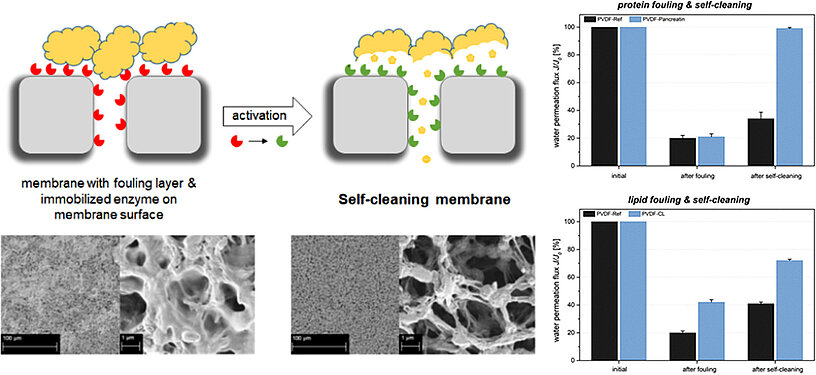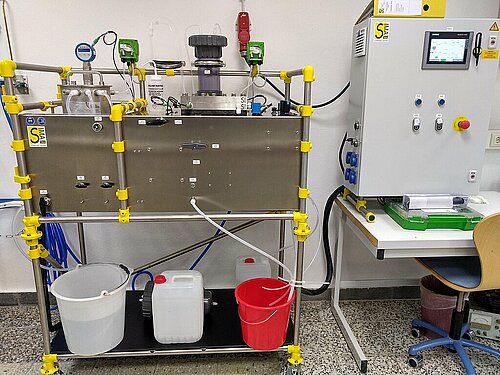Implementierung in reale Anwendungen
Durch den zunehmenden Eintrag von Mikroschadstoffen, wie Hormon- und Arzneistoffen sowie Nitrat/Nitrit, ins Wasser aus anthropogenen Quellen steigt der Bedarf nach neuen Technologien zur Behebung dieser Wasserverschmutzung. Poröse Membranfilter sind ideale Materialien, um sowohl Schadstoffe zu binden, physikalisch abzutrennen oder als Träger von Katalysatoren zu fungieren, um die Schadstoffe direkt abzubauen. Die am IOM in Grundlagenprojekten ermittelten Erkenntnisse werden in Zusammenarbeit mit Partnern aus der Wirtschaft weiter bis hin zum Produkt entwickelt. Die porösen Membranfilter werden dahingehend je nach individueller Problemstellung modifiziert. Dabei kommen folgende Technologien zur Anwendung:
- Adsorption (Ladung, Schlüssel-Schloss-Prinzip, spezifische Wechselwirkungen)
- Photokatalytischer Abbau (TiO2, Photosensibilisatoren)
- Enzymatische Aktivität
- Größenausschluss



Expertise
- Upscaling – Von den Grundlagen zur Anwendung
- Photokatalyse (Abbau in verschiedenen Reaktoren – Batch, Kontinuierlich: Überstrom, Cross-Flow, Dead-End)
- Adsorption (Batch, Kontinuierlich: Überstrom, Cross-Flow, Dead-End)
- Enzyme (Hydrolasen wie Lipasen, Proteasen und Amylasen, Oxidoreduktasen wie Laccase)
- Charakterisierung des Abbaus verschiedener Schadstoffe (Diclofenac, Ibuprofen, Ranitidin, Propanolol, Aspartam, Acesulfam K, Cimetidin, Ofloxacin, Sulfomethoxazol, Glyphosat)
Umfassende Analytik
Auswahl
- Permeabilität (dead-end, cross-flow)
- Bubble point, MWCO, Siebkurvenanalyse, Hg-Porosimetrie
- Kontaktwinkel, Oberflächenenergie
- Zetapotential, Oberflächenladungsdichte
- Proteinadsorption (BCA Test)
- Fouling (Proteine, Algen, Abwasser, Oberflächenwasser,…)
- Toxizität (Leuchtbakterien)
- Enzymaktivitäten (diverse Enzyme)
- Photokatalytische Aktivität (statische und kontinuierliche Betriebsregime)
- Adsorption von Mikroschadstoffen
- REM, TEM, AFM
- Zugversuch, DMA
- TOC, ICP-OES, SPME-GC/MS
- IR, Raman, UV/VIS
- XPS, XRD, EDX
Highlights
Photoactive polymer membranes for degradation of pharmaceuticals from water
J. Becker-Jahn, J. Griebel, S. Glaß, P. Langowski, S. Nieß, A. Schulze
Catal. Today 364 (2021) 256-262
https://doi.org/10.1016/j.cattod.2020.05.017Two different photosensitizer molecules were immobilized on a commercial polyethersulfone membrane by electron beam-mediated grafting. The resulting membrane surface generates singlet oxygen upon activation with light according to the photosensitizer‘s excitation wavelength. Thus, the immobilization procedure results in highly active membrane surfaces. The degradation of different pharmaceuticals (propranolol and ranitidine) by the photoactive membranes was investigated. The activity (singlet oxygen generation rate) and degradation efficiency regarding the two pharmaceuticals was studied next to membrane characteristics (scanning electron microscopy, permeance, contact angle, X-ray photoelectron spectroscopy). The immobilization led to increased surface hydrophilicity and permeance while preserving pore size and morphology. Both photosensitizer membrane systems showed high singlet oxygen generation activity. It was found that propranolol and ranitidine were efficiently converted by singlet oxygen to transformation products, but they were not completely mineralized as monitored by total organic carbon analysis and chromatography.
Photocatalytic degradation of steroid hormone micropollutants by TiO2-coated polyethersulfone membranes in a continuous flow-through process
S. Lotfi, K. Fischer, A. Schulze, A I. Schäfer
Nat. Nanotechnol. 17 (2022) 417-423
10.1038/s41565-022-01074-8Micropollutants in the aquatic environment pose a high risk to both environmental and human health. The photocatalytic degradation of steroid hormones in a flow-through photocatalytic membrane reactor under UV light (365 nm) at environmentally relevant concentrations (50 ng l–1 to 1 mg l–1) was examined using a polyethersulfone–titanium dioxide (PES–TiO2) membrane. The TiO2 nanoparticles (10–30 nm) were immobilized both on the surface and in the nanopores (220 nm) of the membrane. Water quality and operational parameters were evaluated to elucidate the limiting factors in the degradation of steroid hormones. Flow through the photocatalytic membrane increased contact between the micropollutants and ·OH in the pores. Notably, 80% of both oestradiol and oestrone was removed from a 200 ng l–1 feed (at 25 mW cm–2 and 300 l m–2 h–1). Progesterone and testosterone removal was lower at 44% and 33%, respectively. Increasing the oestradiol concentration to 1 mg l–1 resulted in 20% removal, whereas with a 100 ng l–1 solution, a maximum removal of 94% was achieved at 44 mW cm–2 and 60 l m–2 h–1. The effectiveness of the relatively well-known PES–TiO2 membrane for micropollutant removal has been demonstrated; this effectiveness is due to the nanoscale size of the membrane, which provides a high surface area and facilitates close contact of the radicals with the very small (0.8 nm) micropollutant at an extremely low, environmentally relevant concentration (100 ng l–1).
Anti-biofouling membranes via hydrogel electron beam modification – A fundamental and applied study
K. Fischer, J. Lohmann, E. Schmidt, T.H. Blaich, C. Belz, I. Thomas, E. Vogelsberg, A. Schulze
Colloids Surf. A: Physicochem. Eng. Asp. 675 (2023) 132044
https://doi.org/10.1016/j.colsurfa.2023.132044Biofouling is still a major challenge in membrane science and accounts for up to 70% of the total costs of membrane-operated filtration systems. Thus, in this work, a thin layer of diverse synthetic hydrogels has been applied via electron beam-initiated polymerization on a polyethylene terephthalate (PET) track-etched membrane (fundamental study) as a simple model membrane and on a conventional used polyethersulfone (PES) ultrafiltration membrane (applied study) to study its anti-biofouling properties. The effect of hydrophilicity, roughness, surface charge, and degree of swelling of the attached hydrogel on algae (Chlorella Vulgaris) fouling was studied in a fundamental way, and long-time tests in a membrane bioreactor (MBR, filtration area 1.5 m2) over 11 months were performed on an applied scale. The hydrophilicity, roughness, and surface charge had only a minor to no effect on algae fouling. Only the degree of swelling had an impact on biofouling. The membranes with hydrogels with a low degree of swelling (6%) showed a lower loss of permeability (only 5%) after fouling, compared to a 25% loss with the highest degree of swelling (25%). During the operation over 11 months in a membrane bioreactor (MBR), the permeability is higher (ca. 10%) in a module equipped with hydrogel modified membranes, compared to a module with reference membranes. Thus, modification of membranes with a thin layer of a hydrogel results in an anti-biofouling surface. The degree of swelling is a decisive parameter to control biofouling.
Poly(vinylidene fluoride) membrane with immobilized TiO2 for degradation of steroid hormone micropollutants in a photocatalytic membrane reactor
S. Liu, E. Véron, S. Lotfi, K. Fischer, A. Schulze, A. Schäfer
J. Hazard. Mater. 447 (2023) 13082-13096
https://doi.org/10.1016/j.jhazmat.2023.130832The lack of effective technologies to remove steroid hormones (SHs) from aquatic systems is a critical issue for both environment and public health. The performance of a flow-through photocatalytic membrane reactor (PMR) with TiO2 immobilized on a photostable poly(vinylidene fluoride) membrane (PVDF-TiO2) was evaluated in the context of SHs degradation at concentrations from 0.05 to 1000 µg/L under UV exposure (365 nm). A comprehensive investigation into the membrane preparation approach, including varying the surface Ti content and distribution, and membrane pore size, was conducted to gain insights on the rate-limiting steps for the SHs degradation. Increasing surface Ti content from 4 % to 6.5 % enhanced the 17β-estradiol (E2) degradation from 46 ± 12-81 ± 6 %. Apparent degradation kinetics were independent of both TiO2 homogeneity and membrane pore size (0.1-0.45 µm). With optimized conditions, E2 removal was higher than 96 % at environmentally relevant feed concentration (100 ng/L), a flux of 60 L/m2h, 25 mW/cm2, and 6.5 % Ti. These results indicated that the E2 degradation on the PVDF-TiO2 membrane was limited by the catalyst content and light penetration depth. Further exploration of novel TiO2 immobilization approach that can offer a larger catalyst content and light penetration is required to improve the micropollutant removal efficiency in PMR.
Immobilization of Bi2WO6 on Polymer Membranes for Photocatalytic Removal of Micropollutants from Water – A Stable and Visible Light Active Alternative
K. Fischer, A. Abdul Latif, J. Griebel, A. Prager, O. Shayestehpour, S. Zahn, A. Schulze
Global Challenges 8 (2024) 2300198
https://doi.org/10.1002/gch2.202300198In this work, bismuth tungstate Bi2WO6 is immobilized on polymer membranes to photocatalytically remove micropollutants from water as an alternative to titanium dioxide TiO2. A synthesis method for Bi2WO6 preparation and its immobilization on a polymer membrane is developed. Bi2WO6 is characterized using X-ray diffraction and UV–vis reflectance spectroscopy, while the membrane undergoes analysis through scanning electron microscopy, X-ray photoelectron spectroscopy, and degradation experiments. The density of states calculations for TiO2 and Bi2WO6, along with PVDF reactions with potential reactive species, are investigated by density functional theory. The generation of hydroxyl radicals OH• is investigated via the reaction of coumarin to umbelliferone via fluorescence probe detection and electron paramagnetic resonance. Increasing reactant concentration enhances Bi2WO6 crystallinity. Under UV light at pH 7 and 11, the Bi2WO6 membrane completely degrades propranolol in 3 and 1 h, respectively, remaining stable and reusable for over 10 cycles (30 h). Active under visible light with a bandgap of 2.91 eV, the Bi2WO6 membrane demonstrates superior stability compared to a TiO2 membrane during a 7-day exposure to UV light as Bi2WO6 does not generate OH• radicals. The Bi2WO6 membrane is an alternative for water pollutant degradation due to its visible light activity and long-term stability.
